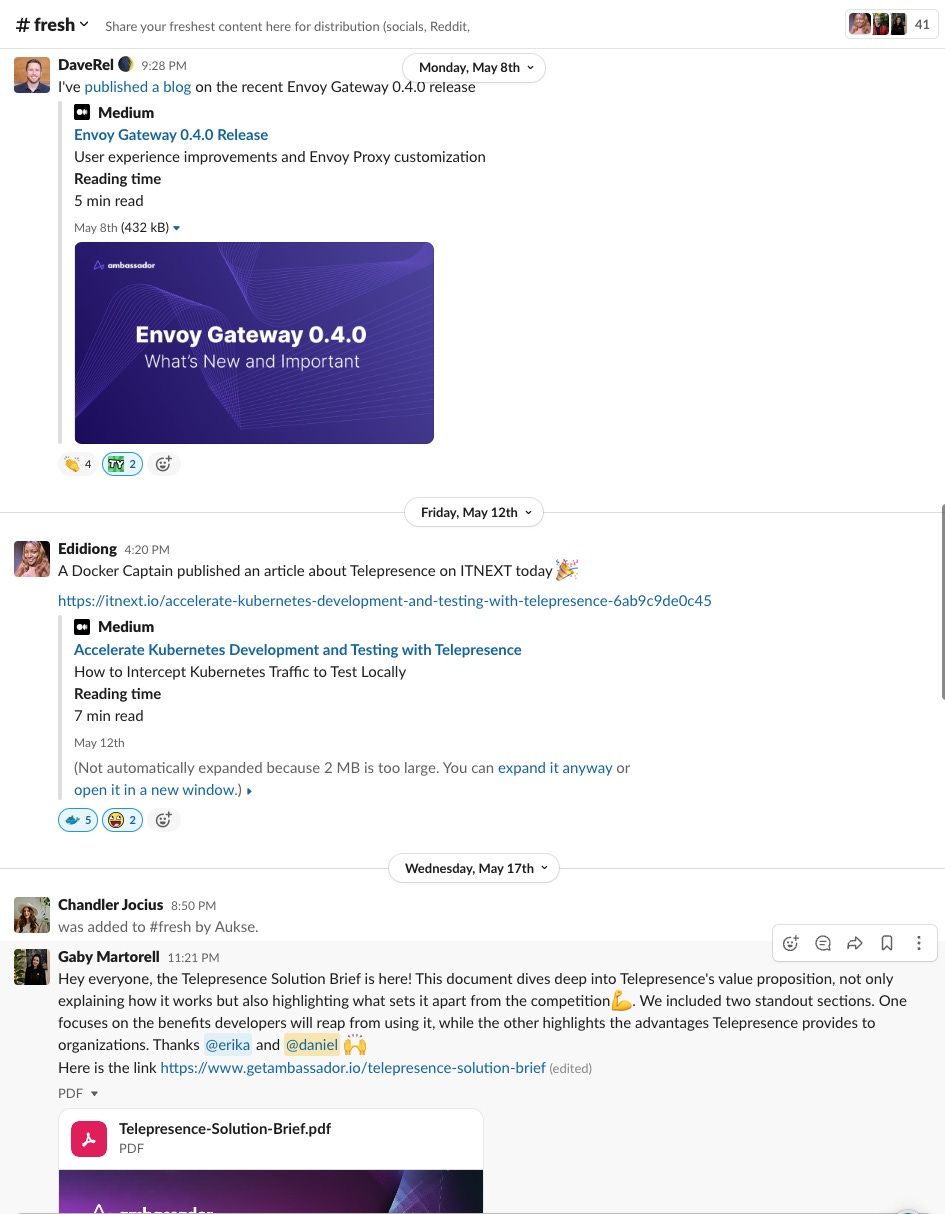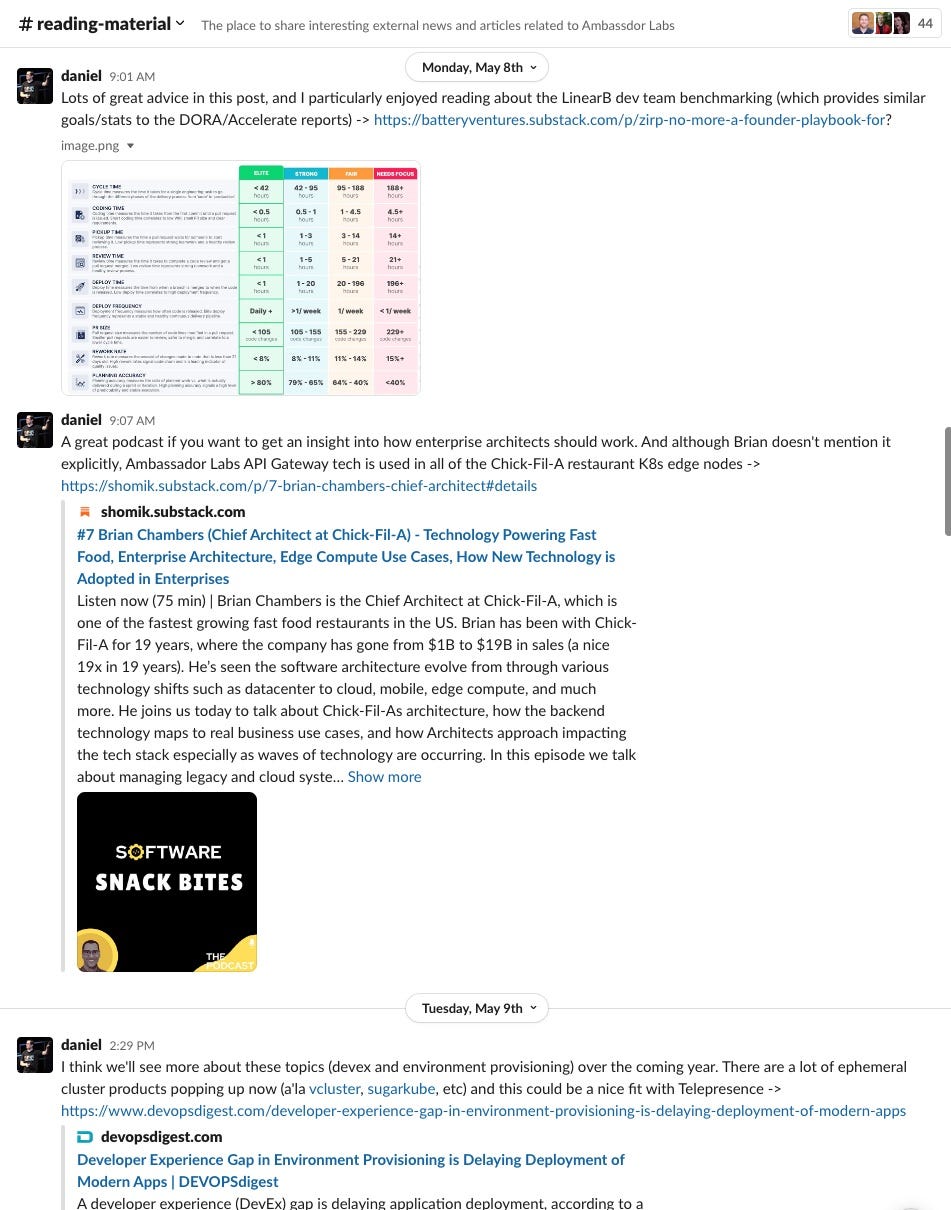Managing DevRel Teams Effectively: Daily and Weekly Tactics
The daily and weekly cadence I use to keep everyone aligned and communicating effectively when leading DevRel and developer advocate teams
During my recent mentoring sessions, many developer relations managers asked what systems and tactics they should implement to manage their teams effectively. This is a fantastic question but also a question with enormous scope! Therefore, in this post, I will “byte” off a small chunk and provide insight into how I learned to manage the work daily and weekly throughout my career.
Working with the leadership team to define organization- and department-level goals and strategy is obviously a vital precursor to some of the advice shared, but I’ll cover that another day. I’ll also skip over some people management things and cover this (super important!) topic in a later post.
Preconditions for successful DevRel management
It should go without saying that as a DevRel manager—indeed, as any manager within an organisation—you need to know and understand the overall leadership goals and strategy and how your team will contribute to this.
In a more mature organization, you will typically (hopefully!) see well-defined goals, objectives and key results (OKRs) and key performance indicators (KPIs). This is great, but let’s be honest, in early-stage startups, the goals can be as simple as “make some noise, help the community, get product feedback, etc.” (ultimately, get sh*t done!). Always push for clarity, but seeking product-market fit can dominate the first year or two of a nascent business, and the DevRel team is often small (maybe just a single person) during this time.
I can’t emphasise enough the importance of being clear on the company goals. I’ve struggled the most with managing teams in my career when I didn’t understand the goals correctly (and at times, this was only obvious with hindsight). Sometimes it was on me—i.e. I should have asked for more clarity and checked my read of the situation was correct—and sometimes, it was on the leadership team for being accidentally/deliberately opaque or changing goals too quickly.
Regardless, I learned to regularly research and echo back my understanding of the company’s north star goals and metrics. I prefer to get constructive feedback early and often rather than fail hard at an arbitrary point.
I’ll mostly use tactics and examples from my time as Head of DevRel at Ambassador Labs. The primary goals during my final year there were mainly around the growth of the community, customer accounts, and revenue. This was a fully remote company, so extra attention had to be paid to communication and alignment. However, most of these tactics can be easily adapted to an in-person situation.
Daily tactics: Alignment, updates, and asking for help
I like to run a “daily standup” to ensure everyone is aware, aligned, and happy with the workstreams we have on deck.
Having wasted far too much time sitting down (ironically) when attending long and tedious in-person standups, I like to organize these asynchronously.
We used a dedicated #team-devrel Slack channel at Ambassador Labs, and each team member would share an update on an automatically generated daily message thread.
I encouraged people to do this when they logged in for the day. We were distributed over nine time zones, and so updates would appear throughout the day.
Here is the format we used for the thread response:
✅ Tasks accomplished yesterday
🎯 Tasks that were planned for the next day or two
⚠️ Warning or caution of a personal issue or task delay
‼ Urgent help is needed on this task
As the team manager, I would check in as each message was added to the thread, and I encouraged the rest of the team to check in as each time zone began their work.
Frequently we would react with emojis to a message or follow up via DMs, a separate thread, or in the main #team-devrel channel.
I’ve blanked out some sensitive things, but this is a typical example of a complete daily check-in from my incredible team at Ambassador Labs!
I’ve found this an excellent way to keep everyone connected, and it also acts as a cue for any dependencies or conversations that need to be resolved each day.
Weekly cadence: Micro-reflection and planning
Although many of the team met and chatted synchronously via Zoom each day, I organized a “DevRel Weekly” session for us to meet.
Each week, we would review our current goals, workstreams, and learnings and also engage in a bit of chatter or “banter”, as we say in the UK! I encouraged everyone to have cameras on and discuss their content and others’ work openly and supportively.
We used a slide deck for this 1 hour meeting primarily to keep us all on track with the discussions. Each team member was responsible for adding content and presenting their work streams, learnings, and questions. I started the session with a “state of the business” and handed it over to the team, MCing where necessary. If anything interesting popped up, we would frequently “put a pin in this” and follow up in another meeting or via DMs.
This is the outline/structure of the slide deck we reviewed each week:
State of the Business: This week’s focus & concerns
How are we doing? North star metrics
Weekly Report Card: KPI analysis
Where are we going? Diving into DevRel deliverables
What are people saying? Voice of our community
What are people saying? Wider and louder!
What are we learning? Key insights (all)
Watch are we watching? TV, book, and culture recommendations
(Unsurprisingly, the final slide was frequently the most popular!):
I’ll shout out my awesome ex-colleague, Kelsey Evans, growth team leader at Ambassador Labs, as I heavily borrowed this slide deck outline from her. 🙌
In addition to the weekly planning and update meeting, I asked the team to spend 15 minutes reflecting on their week at the end of Friday.
I also asked them to send me a short email that answered a series of reflective questions (and a tip of the hat to Richard Li and Bjorn Freeman-Benson for initially creating this habit). I would read and summarise the emails and share the content with my manager and the broader leadership team.
Here are the questions we used for reflection (which evolved multiple times during my tenure at Ambassador Labs):
Your highlights of the week (three sentences, max)
What progress on key challenges did you make this week?
What did you learn this week?
What problems/challenges do you plan on tackling next week?
What challenges/roadblocks do you need help with?
Is there anything else on your mind you’d like to share?
In addition to the summaries for the leadership team, I also summarised and shared critical themes that emerged from these emails and the summary emails from other teams within the organization with my team on Monday morning.
Side note: Big projects need their own cadence
For any big projects or major work streams, such as organizing events like KubeCon EU, the Summer of K8s education program, or our CKAD training article series, we typically would create the following to keep this on track:
Project kick-off meeting and slide deck to get everyone aligned on the desired outcomes, metrics, and accountability
Notion-based Kanban board for tracking deliverables
A project slide deck that was updated each week asynchronously
A weekly cadence meeting to share problems and ensure everyone was aligned. We typically avoided “status meetings” and instead focused on a metrics review, planning for the next week, and a problem/solution brainstorm
Miscellaneous: Keeping other teams informed
The DevRel team regularly shared our deliverables and outputs into a company-wide #fresh Slack channel so that the content could be shared on socials and used by other teams (for example, the sales folks loved this!).
Here is an example highlight from our #fresh channel in May 2023:
In addition to sharing our outputs, we highlighted interesting material and content we found on the Interwebs (which was all part of keeping up to date with news and trends). Here is a screenshot of our #reading-material Slack channel with me providing additional context to content I had been reading in May.
We had channels to share product feedback from the community and our team and ask related questions from the product and engineering teams. I’ll write more about this another time!
Want to know more about managing DevRel teams?
I hope this post has helped to shed some light on how I have managed DevRel teams.
Please comment below and let me know if you want more content on managing and leading in the role of developer relations.
And don’t forget to subscribe! I’m aiming to share a post every two weeks or so.






